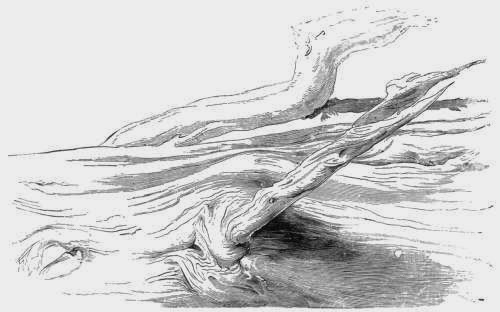3. Strength of Old Pine.
4. Ramification, according to Claude.
§ 12. "Well, but do not the trunks of trees fork, and fork mostly into two
arms at a time?"
Fig. 2.
Yes; but under as stern anatomical law as the limbs of an animal; and those
hooked junctions in Plate 4. are just as accurately representative of the
branching of wood as this (fig. 2.) is of a neck and shoulders. We should object
to such a representation of shoulders, because we have some interest in, and
knowledge of, human form; we do not object to Claude's trees, because we have no
interest in, nor knowledge of, trees. And if it be still alleged that such work
is nevertheless enough to give any one an "idea" of a tree, I answer that it
never gave, nor ever will give, an idea of a tree to any one who loves trees;
and that, moreover, no idea, whatever its pleasantness, is of the smallest
value, which is not founded on simple facts. What pleasantness may be in
wrong ideas
we do not here inquire; the only question for us has always been, and must
always be, What are the facts?§ 13. And assuredly those boughs of Claude's are not facts: and every one of their contours is,art oil paintings for sale, in the worst sense, unfinished, without even the expectation or faint hope of possible refinement ever coming into them. I do not mean to enter here into the discussion of the characters of ramification; that must be in our separate inquiry into tree-structure generally; but I will merely give one piece of Turner's tree-drawing as an example of what finished work really is, even in outline. In plate 5. opposite, fig. 1. is the contour (stripped, like Claude's, of its foliage) of one of the distant tree-stems in the drawing of Bolton Abbey. In order to show its perfectness better by contrast with bad work (as we have had, I imagine, enough of Claude), I will take a bit of Constable; fig. 2. is the principal tree out of the engraving of the Lock on the Stour (Leslie's Life of Constable). It differs from the Claude outlines merely in being the kind of work which is produced by an uninventive person dashing about idly, with a brush, instead of drawing determinately wrong, with a pen: on the one hand worse than Claude's, in being lazier; on the other a little better in being more free, but, as representative of tree-form, of course still wholly barbarous. It is worth while to turn back to the description of the uninventive painter at work on a tree (Vol. II. chapter on Imaginative Association, § 11), for this trunk of Constable's is curiously illustrative of it. One can almost see him, first bending it to the right; then, having gone long enough to the right, turning to the left; then, having gone long enough to the left, away to the right again; then dividing it; and "because there is another tree in the picture with two long branches (in this case there really is), he knows that this ought to have three or four, which must undulate or go backwards and forwards," &c., &c. abstract oil paintings for sale



No comments:
Post a Comment